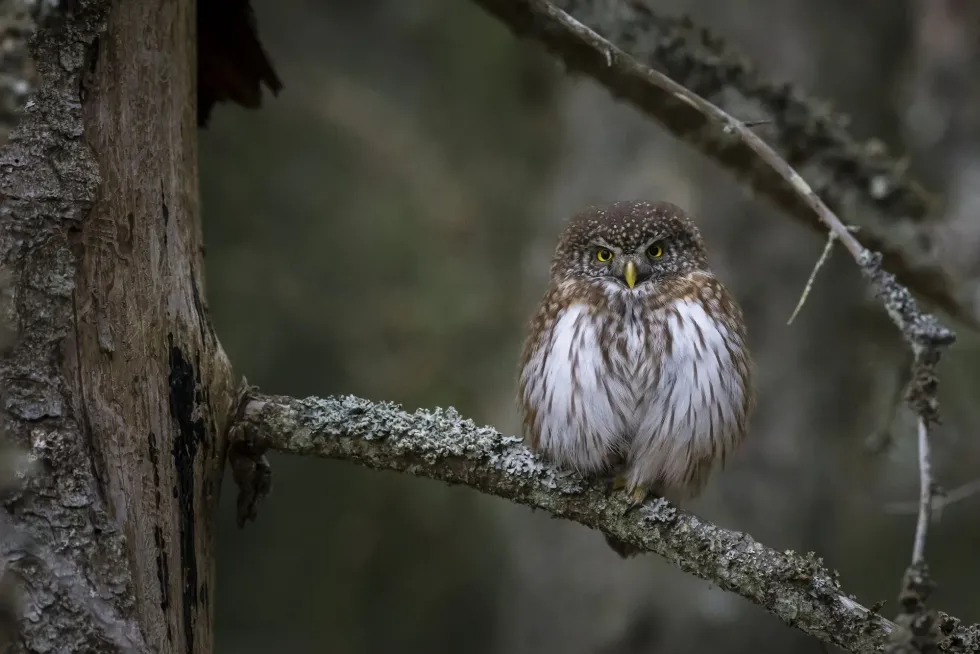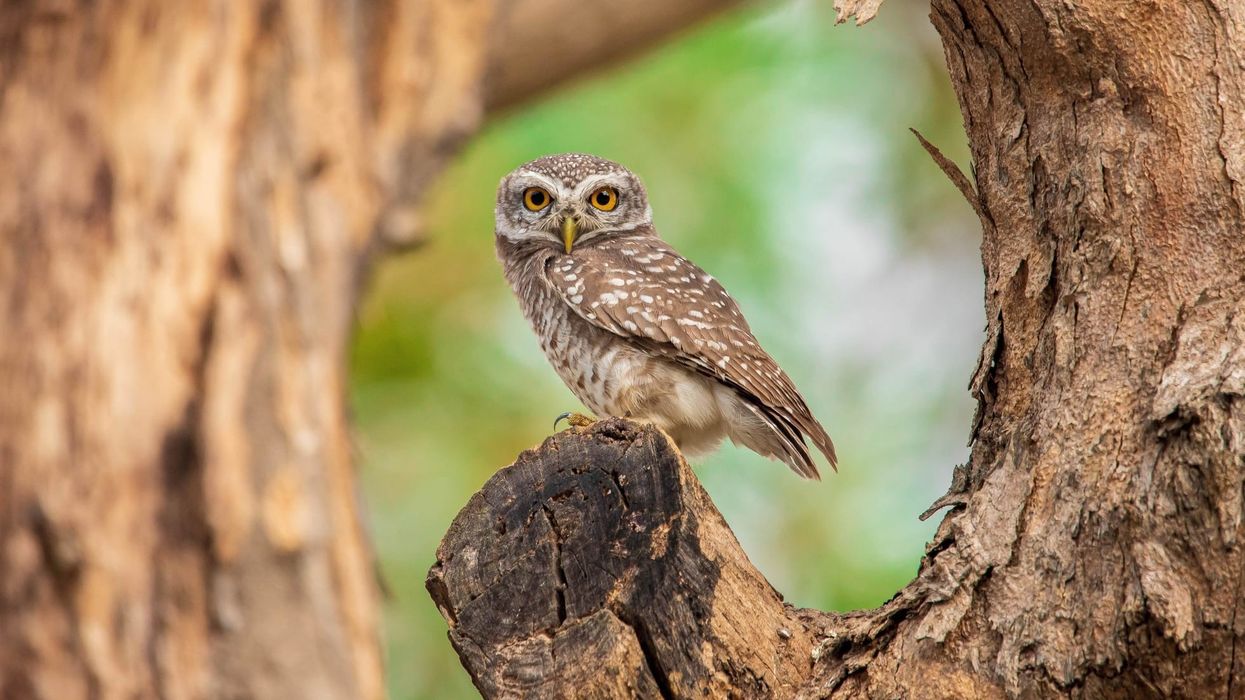The Tamaulipas pygmy owl (Glaucidium sanchezi) is a very small-sized owl endemic to northeast Mexico. These owls have the tiniest range of any pygmy owl in North or Central America. This pygmy owl can be located north of Hidalgo and southeast of San Luis Potosí.
They favor canopies of evergreen cloud forests and are rarely seen. These owls are surprisingly active during the day. They nest in uninhibited old woodpecker holes or tree holes.
Interestingly, they come out of the canopy to hunt their prey. Lizards and various insects are their primary prey. The perfect way to identify them is by becoming familiar with their distinguishing calls.
Unfortunately, not much is known about these owls due to a lack of verifiable data about them. However, there are still a few facts and information available about them. Read on to learn more about this enigmatic bird.
For more relatable content, check out these flammulated owl facts and rufous owl facts for kids.
Tamaulipas Pygmy Owl Interesting Facts
What type of animal is a Tamaulipas pygmy owl?
This pygmy owl is a species of bird from the order Strigiformes, family Strigidae. It is a type of owl.
What class of animal does a Tamaulipas pygmy owl belong to?
Like all birds, these owls belong to the Aves class and are part of the order Strigiformes, family Strigidae.
How many Tamaulipas pygmy owls are there in the world?
Currently, this species has an estimated population of less than 50,000 on the planet.
Where does a Tamaulipas pygmy owl live?
These pygmy owls are endemic to Mexico. Found primarily in the mountain range of northeast Mexico, they can be located north of Hidalgo and southeast of San Luis Potosí.
What is a Tamaulipas pygmy owl's habitat?
They can be found in areas with cloud forest and subtropical pine evergreen forest at a height of 3,000-7,000 ft (900-2100m).
Who does a Tamaulipas pygmy owl live with?
Like most owl species, they also live in solitary or in pairs. During breeding time, they live as a family.
How long does a Tamaulipas pygmy owl live?
No information is available related to their lifespan.
How do they reproduce?
Not many breeding details are available for this pygmy owl species. The breeding process is believed to be similar in nature in comparison with other pygmy owls.
They commonly nest in uninhibited old woodpecker holes or tree holes. Female owl lays two to four eggs and the eggs are white in color.
During this time, the male takes care of hunting, and the female stays in the nest, takes care of the eggs, and later feeds and provides care for the hatchlings. At fledging, juveniles are capable of short-distance flights.
What is their conservation status?
Due to deforestation, their range of habitat and population are significantly declining. As a result, the population of this pygmy owl species is rated as Near Threatened by the IUCN in their Red List. They have an estimated population range of less than 50,000 in the entire world.
Tamaulipas Pygmy Owl Fun Facts
What does Tamaulipas pygmy owl look like?
The Tamaulipas pygmy owl (Glaucidium sanchezi) is a small-sized owl of length just between 5.1-6.3 in (13-16 cm), along with a wingspan of 3.4-3.8 in (8.6-9.6 cm)and a tail length of 2-2.2 in (5-5.8 cm).
These birds have a brown facial disc speckled with whitish buff, whitish eyebrows, and yellow eyes. The nostril area is a blend of yellow and gray in color, and the bill is buff or yellow too.
The male has a crown that is a mixture of gray and brown in color. The nape has a buff coloration with streaks of white and there are whitish spots on the crown.
The spots are extended from the crown to the nape and the coloration of the nape is contrasted with the olive-brown coloration on the back. Interestingly, the nape can have olive-brown plumage with a hint of gray.
On the sides of the upper breast, there are reddish-brown spots. The front sides and underparts have streaks of dark reddish-brown, and the six whitish tail stripes are tinged buff to pale bark-brown.
Their tarsi are covered in feathers and yellow-gray in color. Claws are designed for hunting and have darker pointy tips.
Female owls have a crown. Compared to males, their crown, nape, and upperparts more reddish-brown in color.

How cute are they?
In general, all owls are considered cute birds. They have a pair of large eyes and a tiny bill. The way they twist their head to look around their surroundings is quite fascinating. The super small size of a Tamaulipas pygmy owl (Glaucidium sanchezi) makes them a cute bird.
How do they communicate?
They communicate primarily through acoustic means. They have high-pitched, hollow, slow-paced, and longer hoots and whistles.
How big is a Tamaulipas pygmy owl?
Only 5.1-6.3 in (13-16 cm) in length, a Tamaulipas pygmy owl (Glaucidium sanchezi) is a very small-sized owl. They are almost the same size compared to the Ferruginous pygmy owl found in South America, Central America, and Mexico.
On the other hand, they are three times smaller than the average barn owl. Even the great grey owl is somewhere between four to five times bigger than these pygmy owls.
How fast can a Tamaulipas pygmy owl fly?
No quantitative data is available related to their flying speed, however, it has been observed that they fly pretty fast and low while hunting.
How much does a Tamaulipas pygmy owl weigh?
This owl species is quite lightweight. An adult weighs approximately just between 1.8-1.9 oz (51-55 g). Adult males are usually lighter than adult females showing sexual dimorphism. In comparison, short-eared owls are almost seven times heavier than them.
What are the male and female names of the species?
They do not have distinguishing names for male and female birds of this species.
What would you call a baby Tamaulipas pygmy owl?
The juveniles do not have a specific name. You can call them a chick or a hatchling, like we do with many other birds.
What do they eat?
This species of owls are carnivorous in nature, and their diet consists of a a variety of insects and lizards. They mostly prey on a range of grasshoppers, beetles, crickets, or similar large-sized insects and small-sized lizards.
Are they dangerous?
They are carnivorous predators. However, they are solitary birds and live far away the human locality. They prey mostly on various insects and small lizards that suit their small size. Humans basically pose no threats or danger from them.
Would they make a good pet?
Because of its small size and cute appearance, there may be a temptation to have one of these owls as a pet. However, in general, owls are not good pets as they are hard to train.
Moreover, in many countries, there could be a legal restriction to have them as a pet. This species of bird is far from an ideal pet, especially as it is Near Threatened and should be protected in the wild.
Did you know...
Like other species of owls, this species cannot move its eyes in any direction. To compensate for this shortcoming, they have gained the ability to rotate their head 270 degrees.
Most species of owls are usually nocturnal, but Tamaulipas pygmy owls are diurnal. They remain active in the presence of daylight.
The Tamaulipas pygmy owl is very similar to the Central American pygmy owl, found in north to southeastern Mexico. According to many, these two species are allopatric.
The Tamaulipas pygmy owl does not migrate.
Which is the smallest European owl?
The Eurasian pygmy owl is the smallest owl found in Europe. They are found in the snow forests of northern and Central Europe to Siberia. This species has a wide range across different countries.
Why are pygmy owls endangered?
Pygmy owls face conservation issues due to a loss of habitats and poaching. This species of Tamaulipas pygmy owls are endemic to Mexico and inhabits very specific climates such as cloud forests and humid evergreen forests.
Due to massive deforestation, their habitat is shrinking day by day. A few years back, these owls had a Least Concern conservation status which has now been updated to Near Threatened.
Here at Kidadl, we have carefully created lots of interesting family-friendly animal facts for everyone to discover! Learn more about some other birds from our American avocet facts and Florida scrub jay facts pages.
You can even occupy yourself at home by coloring in one of our free printable Tamaulipas pygmy owl coloring pages.









